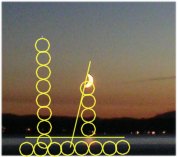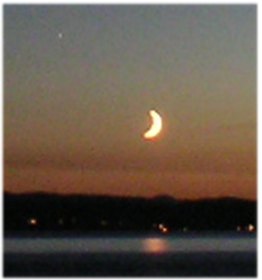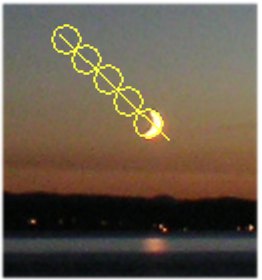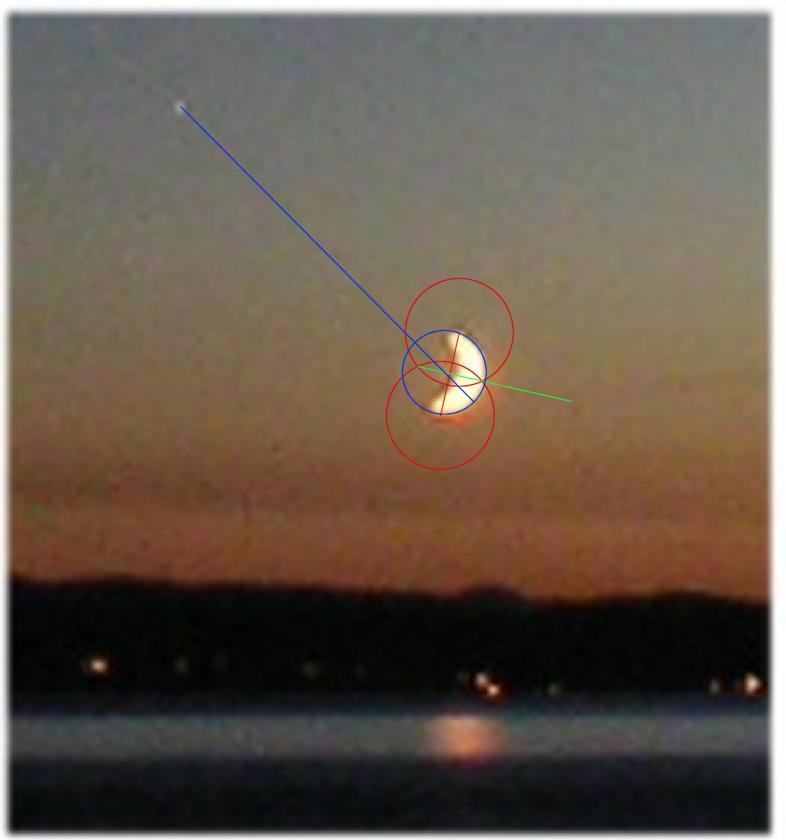|
Author
|
Topic: Photographic sextant sights + moon horns
|
David Burch
|
 posted August 27, 2006 10:31 PM
posted August 27, 2006 10:31 PM


Here are more data on photographic sextant sights and moon horn bearings... the first idea is how well can we get a sight from a photograph using sun or moon semi-diameter to scale the picture, and the latter idea (see separate topic) is to what extent do the moons horns point to south.
The picture below was taken in rather dark conditions with an inexpensive digital camera resting on a rail using electronic zoom. It sounded like the exposure time was about 1 second.

This picture is from aug 27 at about 9:00 PM ± 2min PDT from 47° 40.5 N and 122° 24.5 W. A computation of exact values at 0400 8.28.06 UTC for these data gives Hc moon = 2° 16.4' at Zn=251.2 T. The star the left is Spica which had Hc = 3° 9.0' at Zn = 249.6.
The moon SD = 14.8', so the circle shown has diameter 29.6'.
The first thing we see is the moon's horns in this case are not a good S indicator. They point to about 30' south of 251.2 = 250.7, which is some 71° north of south. A "hocky puck" compass bearing to the moon was 236 M (253.6 T). Note that we do get the spica moon separation (251.2 - 249.6 = 1.6° = 96' = 3.24 moon diameters) very precisely.
The heights in both cases turn out to be remarkably accurate figured this way, which we can tell even without knowing the precise time.
Study the picture carefully (circle diameter is 13 pixels) to see that Hs to spica is (7 x 13 + 4 )x 29.6' = 3° 36.3' and to the center of the moon is 4 x 29.6 = 1° 58.4'.
When you do a sight reduction at 0400 Z for these two sights you get for spica 8.5' T 249.5 and for moon 11.4' T 251.2. So the LOPs are remarkavbly close, with within 11 miles in both cases. But we still do not get too good a fix because they are so close in Zn. A careful plot or computation shows a fix of 49° 11' N, 123° 30' W. Not so bad for doing from a cheap photograph without accurate time.
But now we might tweek a bit since we did not have the time recorded, and say can we tweek the time to make both better. That is, if we guess the real time was 0359 z instead of 0400, both intercepts are less than 1', and the fix moves towards us some.
Also we need to eventually evaluate dip short and effect of eye height... we were at about 15 feet and the shoreline under the moon is about 3.6 to 4 miles off, right on the edge of dip short requirement, depending on the details.
Thus it seems from these data that we can get good emergency sights from a photo -- even a cell phone photo -- and it will be interesting to evaluate more data.
On the other hand, the moons horns as a guide to south is going to take more work. we need to develop some criteria that will set limits on its accuracy. So far the cases that have failed the most were new moons. So perhaps this can be done in terms of moon phase or age. this moon was age 3 days.
Note that the one proposal that we have found in print suggests that the method is restricted to quarter moons (ie half moon in the sky).
From: Starpath, Seattle, WA
|
|
David Burch
|
 posted August 28, 2006 05:00 PM
posted August 28, 2006 05:00 PM


For what it might be worth, on the next day, aug 24 at 1500 PDT the same moon was at about 155 T at 24° high in the southern sky and the horns pointed almost exactly to due south. this was age 4 days. So the answer for a good criteria is not just in the age. Near the meridian this is an excellent pointer but near the horizon it is not.
Of course we cannot use that it must be near the meridian in order to be a good way to find the meridian, so back to the drawing table.
From: Starpath, Seattle, WA
|
|
David Burch
|
 posted September 10, 2006 06:44 PM
posted September 10, 2006 06:44 PM


A recent article in the Navigator's Newsletter led us to see what we might get out of this picture in terms of lunar distance. Here is the same picture unmarked to show Spica. Same as earlier picture, just enlarged, and then another marked to show the moon-Spica separation in terms of moon diameters.
 
In these pictures, the circle is 30 pixels in diameter which leads to a lunar distance of 2° 22.1' for DR 47 40, 122 24 at 0400 UTC aug 28, 2006.
We computed the correct longitude based on this from the StarPilot program (it does lunar distance computations) and got 114° 8' W and also used an online Lunar distance program which gave 114° 22'. For now we have not figured out why these two are different — 14' at 48 N is 9 nmi.
Also, more to the point, we are not sure yet if this overall difference 122 24 (actual) vs 114 15 (determined by the photo) is larger or smaller than expected. This is about 340 nmi.
We will think on this some and come back to it. Lunar distance from photographs is a new idea and we may be missing some fundamental point here. If you have ideas on this, please post them.
Note that what we are doing is trying to find out what time is it is by taking a picture of the moon. So far what we found is wrong by about 30 minutes.
Note that the left hand picture above is the raw data we started from. Nothing more. So reader are welcome to analyze it themselves to see if you get a difference lunar distance.
From: Starpath, Seattle, WA
|
|
David Burch
|
 posted October 31, 2006 10:13 PM
posted October 31, 2006 10:13 PM


after analyzing the moon-jupiter pic in the next topic, we decided to come back to this one and try a better analysis. the big difference is this one is a very poor photo and the other was a very good photo.
and in the jupiter case we knew the time. in this case we did not, so we have studied the heights to see what the time must have been if the heights we measured from the photo were correct-- this is crude too, but it is better than just guessing 0400 within 2 minutes.
we find that to get the star height listed above the time had to have been 3h 58m 41s and to get the moon height right the time had to be 3h 58m 19s, so we just average these and get 3h 58m 30s. then we blow up the picture and find a moon diameter of 85 pixels and the lunar distance = root (294^2 + 296^2) = 417.2/85 = 4.91 diameters x 29.6' = 2 deg 25.3'.
then if we do the lunar distance analysis with the online site listed we get lunar error of 13.2' and longitude error of 6 deg 36.7'.
this is an improvement. we are now off by 262 miles instead of 340.... keep in mind what we are doing here, or at least attempting to. That is, we take a picture of the moon with a cell phone and find out where we are to within 262 miles -- without knowing what time it is. we had to have an almanac and we had to know how to do the analysis, but there was no sextant and no timepiece in the process.

note on another topic that this poor picture does show something special about the moon... a common hazzard in doing moon sights is to get the horizon wrong... the lighted up horizon is ofen too close. look carefully here and see the true sea shore horizon is actually about half the width of the bright band above the top of that band. if you do not look carefully when doing moon sights you can get this wrong sometimes.
If you in error used the top of the bright band for the horizon, your sights would be too big by about 8' judging this width relative to the diameter of the moon, 29.6'.
From: Starpath, Seattle, WA
|
|
|









